Day 2 of a three day Late Autumn Tour. It was forecast to rain heavily for most of the morning and into the afternoon, but thankfully yet again the forecast was wrong. There was heavy drizzle for about 15 minutes mid morning, and some short spells of light drizzle at times through the rest of the day too, but nothing like as bad as we were led to expect by the Met Office.
Given the forecast, we headed over to Titchwell this morning, where we could get into the hides. On our way, we could still see clear skies away to the north and the bank of high cloud as overhead as the front arrived from the SW. We had a quick look round the car parks first. Scanning from the gate at the far end, we could see a few Blackbirds and Starlings in the paddocks. A Redwing appeared in the hedge, where we could get it in the scope for a closer look.
Continuing round, several finches flew over – Greenfinches, Chaffinches and a couple of Siskin. A Kestrel was hovering over the edge of the paddocks, and seemed to flush a few Meadow Pipits and a Reed Bunting which came up and over us too. The bushes in the overflow car park were quiet this morning, but we came across a tit flock in the main car park – Long-tailed Tits and Blue Tits. A Goldcrest flitted through the oaks. We followed the flock to the far corner where it disappeared quickly into the sallows towards Fen Trail.
It started to drizzle while we were in the car park, which we thought might be the beginning of the forecast rain, but it stopped again almost immediately. We carried on round past the Visitor Centre, and as we walked up along the main path we noticed movement in the ditch below us. A Water Rail was picking around in the bottom of the ditch – we watched it feeding furtively. They can often be found here in the winter, but this might be the first one here this autumn.
Out of the trees, and a Marsh Harrier was up over the back of the reedbed and a Kestrel was hovering in the distance, but there didn’t seem to many birds moving today. Several Coot in the channels and two Common Pochard on the reedbed pool were new for the trip list. There were a few Curlew, Redshank and Little Egrets over the saltmarsh, where several Skylarks and pipits chased each other round too, the latter a mixture of Meadow Pipits and one or two Rock Pipits.
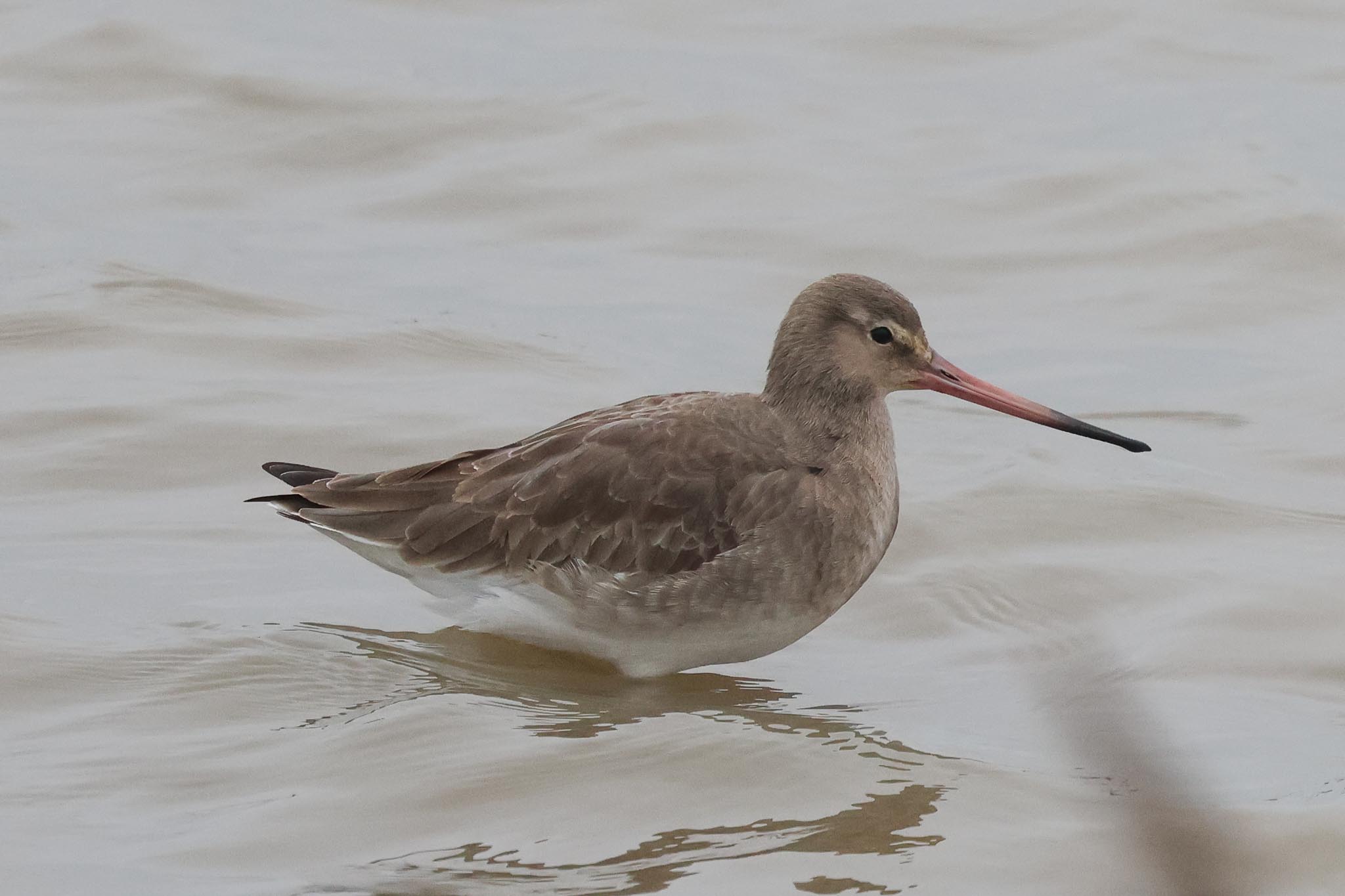
As the weather was still holding off, we decided to head out to the beach first, and then head back to the hides when the rain arrived. We stopped at the freshmarsh to have a quick scan and get the scopes on two Common Snipe which were feeding on one of the islands. There were lots of Avocets and Black-tailed Godwits roosting further back on the first compartment, as well as a selection of ducks, but not much on the next compartment.
Pushing on, the tide was high on Volunteer Marsh now. A Great White Egret was over in front of Parrinder hide. It flew up and landed a little further back, helpfully right next to a Little Egret so we had a great comparison view through the scopes and could really appreciate the size difference between the two.
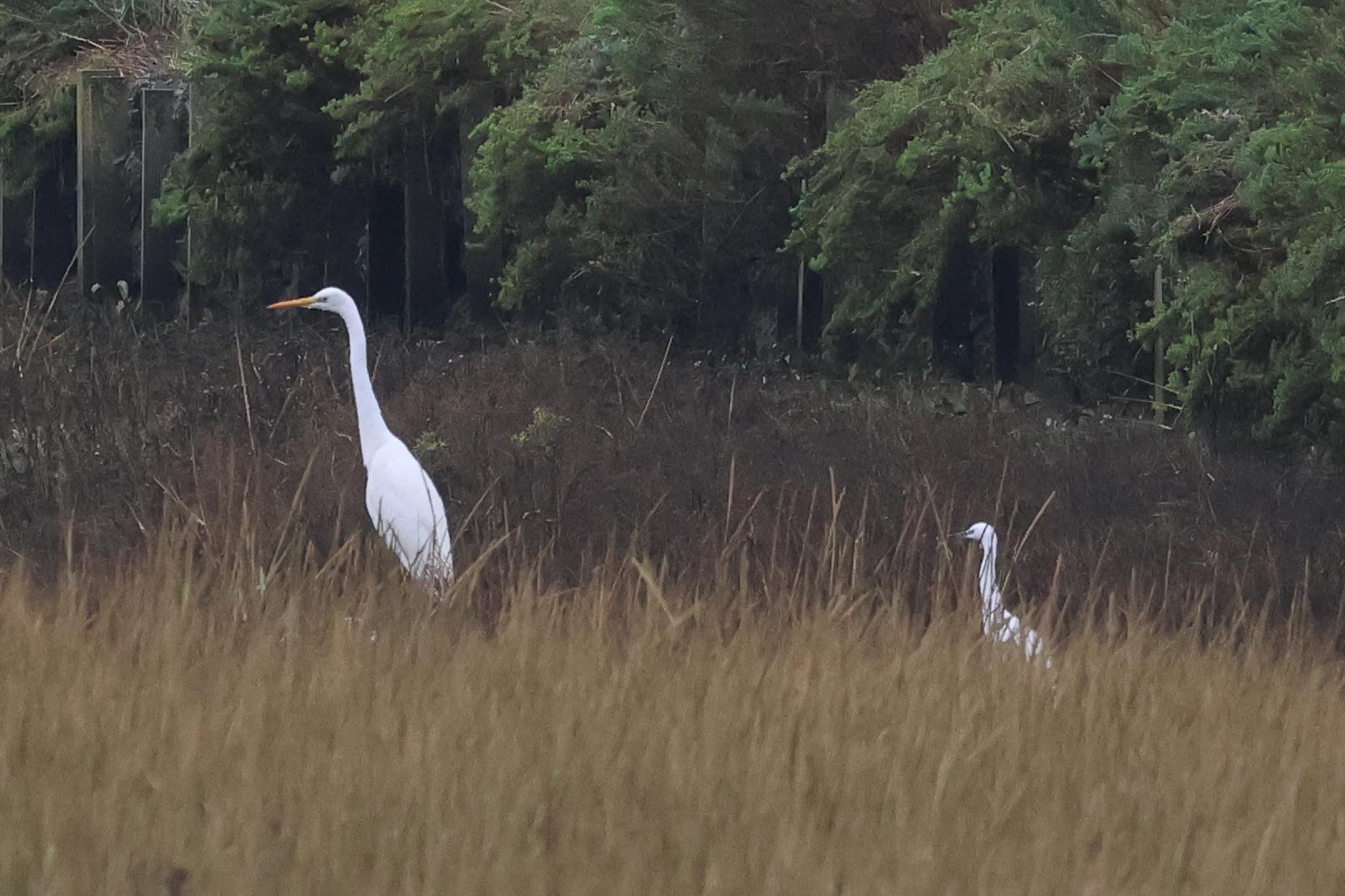
There were a few Teal in the channels, including a drake displaying to two females already, bobbing its head up and down as it swam after them. There were lots of Wigeon too and a single Great Crested Grebe at the back of the big channel at the far end of Volunteer Marsh. Several Curlew, Redshank and a Dunlin were feeding on the muddy edges. Another Little Egret was down at the front, although its yellow feet were a bit muddy.
Continuing over the bank to the Tidal Pool, and the first bird we noticed was a Greenshank on one of the muddy islands close to the path. It seemed unconcerned by people walking past and we had great close views. A Spotted Redshank was feeding a bit further back, which we got in the scope so we could see its needle-fine bill. Both species are mainly passage migrants through here, in spring and autumn, but small numbers stay for the winter, feeding mostly in the saltmarsh channels at low tide. It was high tide now, so a good time to find them on here.

Further on, we could see a flock of Dunlin feeding out on the saltmarsh island, along with a few Turnstones, and a line of several Grey Plover roosting on the edge of the water. A small flock of Brent Geese were feeding on one of the pools on the Thornham side of the bank.
We pressed on and out to the beach. With the tide in, a large group of Oystercatchers was roosting out along the beach to the east, and through the scopes we could see a smaller number of Bar-tailed Godwits in with them. A couple of Sanderings and a Turnstone were closer to us on the shore. Looking out to sea, we could see a large raft of Common Scoter offshore, and several Great Crested Grebes. Looking away towards Brancaster, we picked up a Red-necked Grebe just off the beach. Unfortunately it dived and we lost track of it before everyone could get a look.
We could see dark clouds approaching from behind us now and it started to drizzle. The visibility out to sea steadily deteriorated, until we couldn’t even see down to Scolt Head any more. Half of the group decided to head back to Parrinder hide now, but three of us decided to stay a little longer to see if we could find the Red-necked Grebe again.
After a short while, we looked back again and the skies seemed to be brightening up to the south, so we decided to stick it out. A larger flock of Sanderling flew in and landed right in front of us, running past on the high tide line fearlessly. We picked up one or two small passerines coming in off the sea distantly to the east, but we couldn’t make out what they were in drizzle. Thankfully, the rain quickly cleared through, it brightened up and dried out.
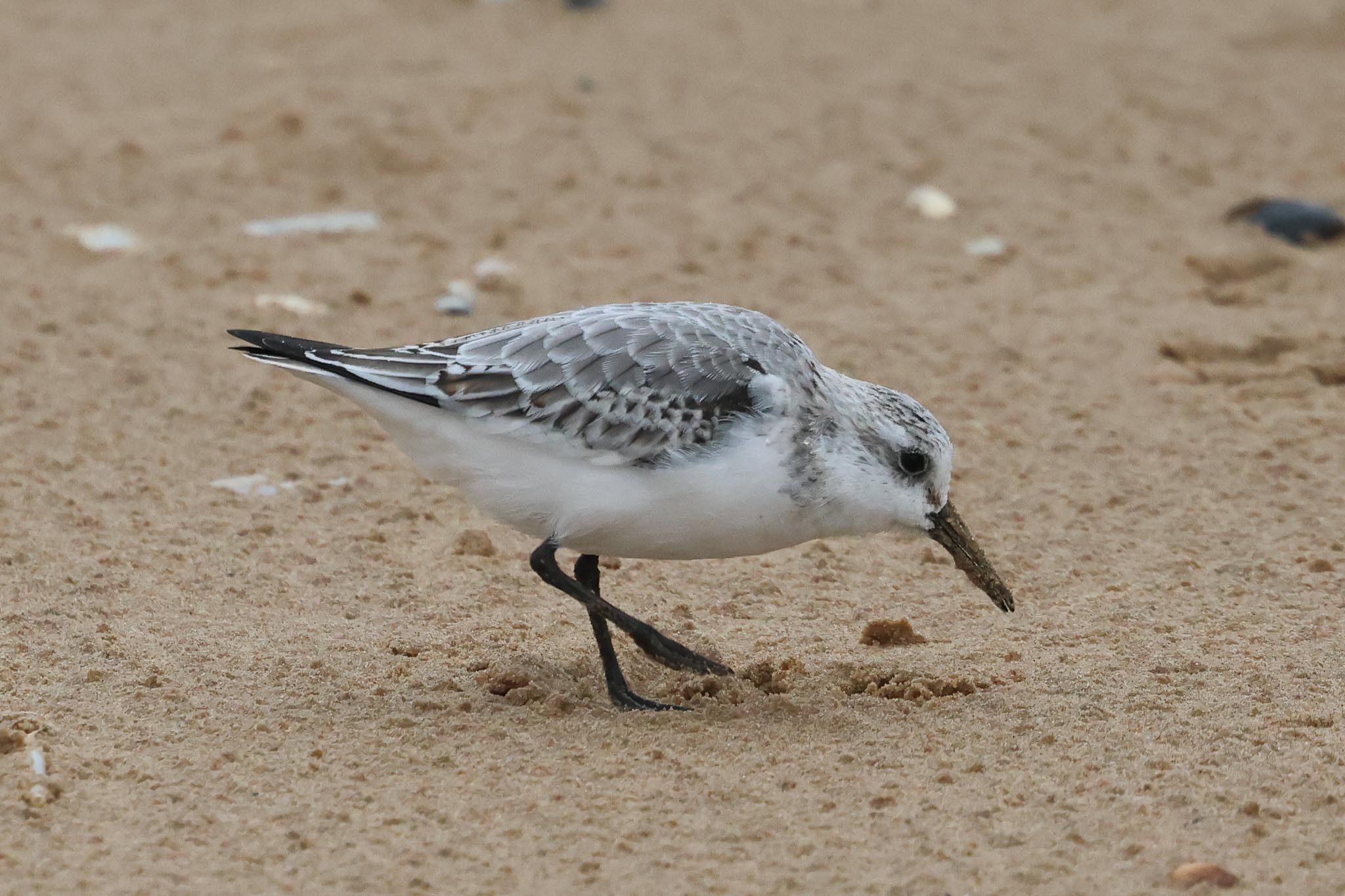
We scanned the sea again and relocated the Red-necked Grebe, a bit further away to the east now, but a particular target for one of the members of the group who had stayed out through the rain. We looked more carefully through the raft of the Common Scoter, but couldn’t see anything in with them, then found a single Velvet Scoter on its own further over. We could see the white flash in its wings.
We headed back to Parrinder Hide now to meet the others. The Greenshank was still on the Tidal Pool but there was no sign of the Spotted Redshank now. The channel on Volunteer Marsh was still full of water.
In Parrinder Hide, we found the others watching some Teal on the bank in front of the hide. They were repeatedly walking up the bank to break off bits of vegetation in their bills, then going down to the water to wash it. A single Dunlin was on the bank opposite and a Ringed Plover flew across to the island in front. The Black-tailed Godwits were still on the next compartment over, but the Avocets were now scattered all round. A Kingfisher shot across in front of the hide, but disappeared into the bank away to the left.
We had a quick look on the other side of Parrinder Hide, overlooking Volunteer Marsh. Over the last ten or so years the mud on here has become nearly completely vegetated over now – a small open patch in front of the hide held a single Redshank, and a Grey Plover was further back on a small area of mud in front of the reeds. There was no sign of the Great White Egret now.
As we walked back, a smart male Marsh Harrier was perched in the dead trees at the back of the reedbed. We cut in round along Meadow Trail and Fen Trail, which was quiet apart from a few Long-tailed Tits and Blue Tits in the trees. A couple of Goldfinches flew up from the edge of the Tank Road and a Reed Bunting perched up in the hedge. We could hear a Greenshank calling as we walked up to Patsy’s, and we found it out in the shallow water with the bathing gulls, before it flew off. A pair of Shelduck were out on the water too and a couple of Marsh Harriers flew back and forth over the reedbed beyond
We headed back to the Visitor Centre for lunch and a welcome hot drink. The tables were damp, but the weather was still dry now so we could sit outside. We had originally intended to head over to Snettisham this afternoon to look for Shorelarks, but a Red-breasted Goose had been found at Warham Greens earlier and last winter’s Pallid Harrier had reappeared there in the roost again last night, so we decided to head over there instead.
As we drove back east, the Warham tracks looked very busy, so we continued on to Stiffkey Greenway, which would be closer for the goose but perhaps not such a good place from which to look for the harrier. As we walked west along the coast path, it started to drizzle again. Several small flocks of Brent Geese were out on the saltmarsh, along with Curlews, Redshank and Little Egrets. Several Blackbirds flew out of the bushes ahead of us – more lingering migrants possibly arrived from Scandinavia.
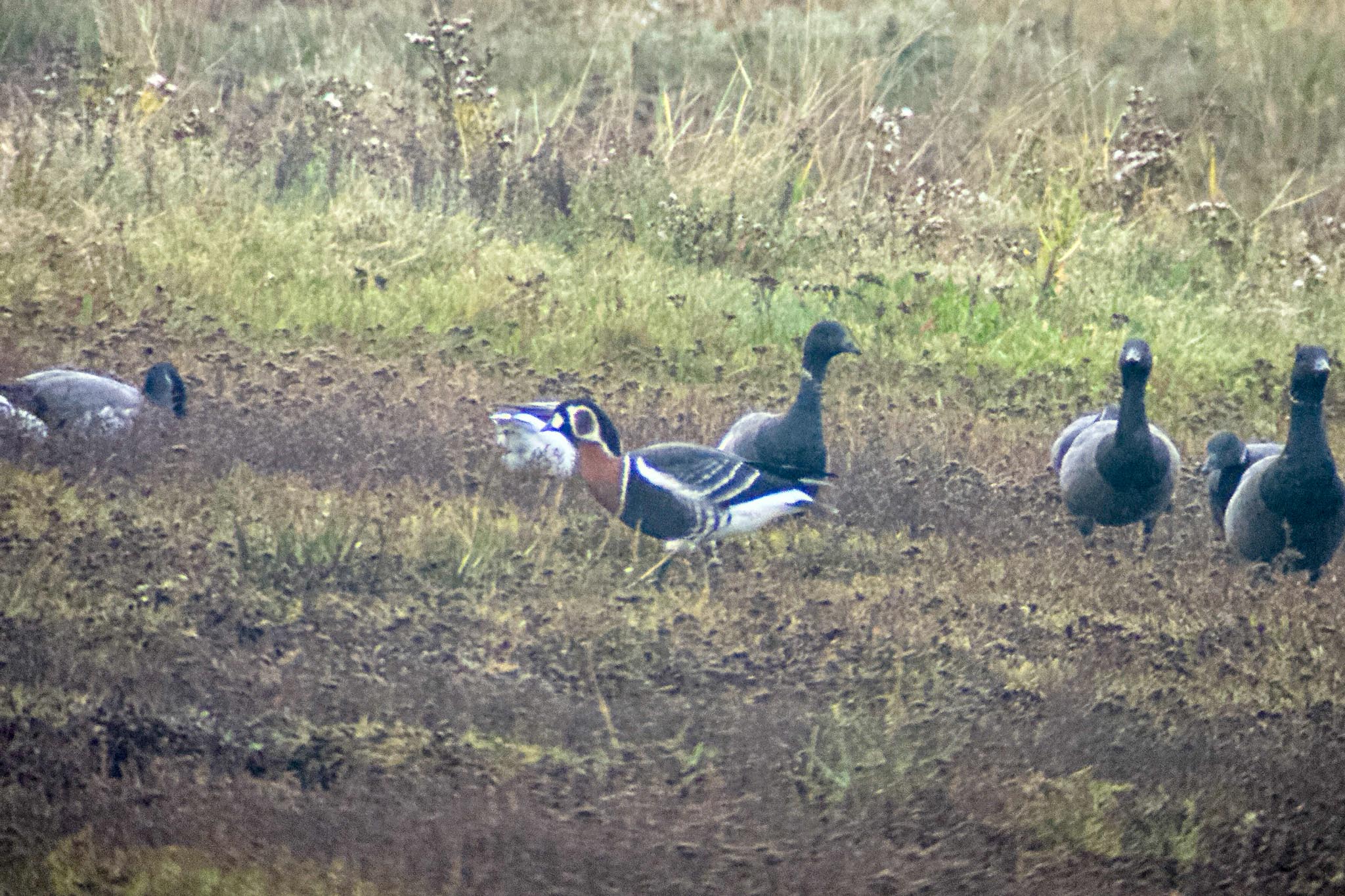
The Red-breasted Goose had been reported from the saltmarsh west of the Whirligig, so we scanned first from the tarmac path there. We couldn’t see the goose but we could see a few people standing further down along the coast path, so we headed over there. Before we even got to them, we could see the Red-breasted Goose out on the saltmarsh with a small group of Brent Geese. It was a bit misty at times, due to the drizzle, but we all enjoyed good views through the scope as it fed with the Brents.
Wild Red-breasted Geese are very occasional visitors here, although they are common in captivity and escapes sometimes turn up too. Breeding in Arctic Siberia, they spend the winter mostly around the Black Sea. Our Dark-bellied Brent Geese breed in Siberia too, so lost Red-breasted Geese can sometimes join up with the flocks of Brents and follow them here to the UK for the winter. We had one with the Brents at Cley and Blakeney for several weeks early in 2022, but this is a different bird, a juvenile born this year.
With good views of the Red-breasted Goose secured, we turned our attention to the other bids. A ringtail Hen Harrier flew through low over the middle of the saltmarsh and off east and several Marsh Harriers patrolled up and down further back. A large flock of Golden Plover came up off the saltmarsh over towards Blakeney harbour, but disappeared into the mist as they climbed up.
We could see patches of blue sky behind us, the drizzle stopped and it started to brighten up. Just at that moment, a gas gun bird scarer went off with a loud bang behind us. The geese all took off and flew back away over the saltmarsh, splitting up into several splinter groups. We lost track of the Red-breasted Goose. There were more flocks of waders, large groups of Knot, whirling round over the beach in the low sunlight now.
The Pallid Harrier had first been seen late last night, and then again this morning. It had probably roosted here, as it did for most of last winter. There had already been a report of is again this afternoon, but further to the west of us at Garden Drove. We kept scanning the saltmarsh away to the west, and some of the areas it liked to perch last winter, to see if it might be coming in to roost, but there was no sign yet. We figured it was probably still out hunting, given how nice the weather was now.
We were just watching a Marsh Harrier over one of the old dune ridges to the NE, when one of the group noticed a harrier high over the saltmarsh just in front of us. We looked up, and as it circled round it looked distinctly falcon-like, with very pointed wings. The Pallid Harrier! We got the scope on it, and could see it only had four long primaries, which gives it the more pointed wing than Hen Harrier, which has five. It gradually drifted out over the saltmarsh as it circled, then it turned and flew off west.
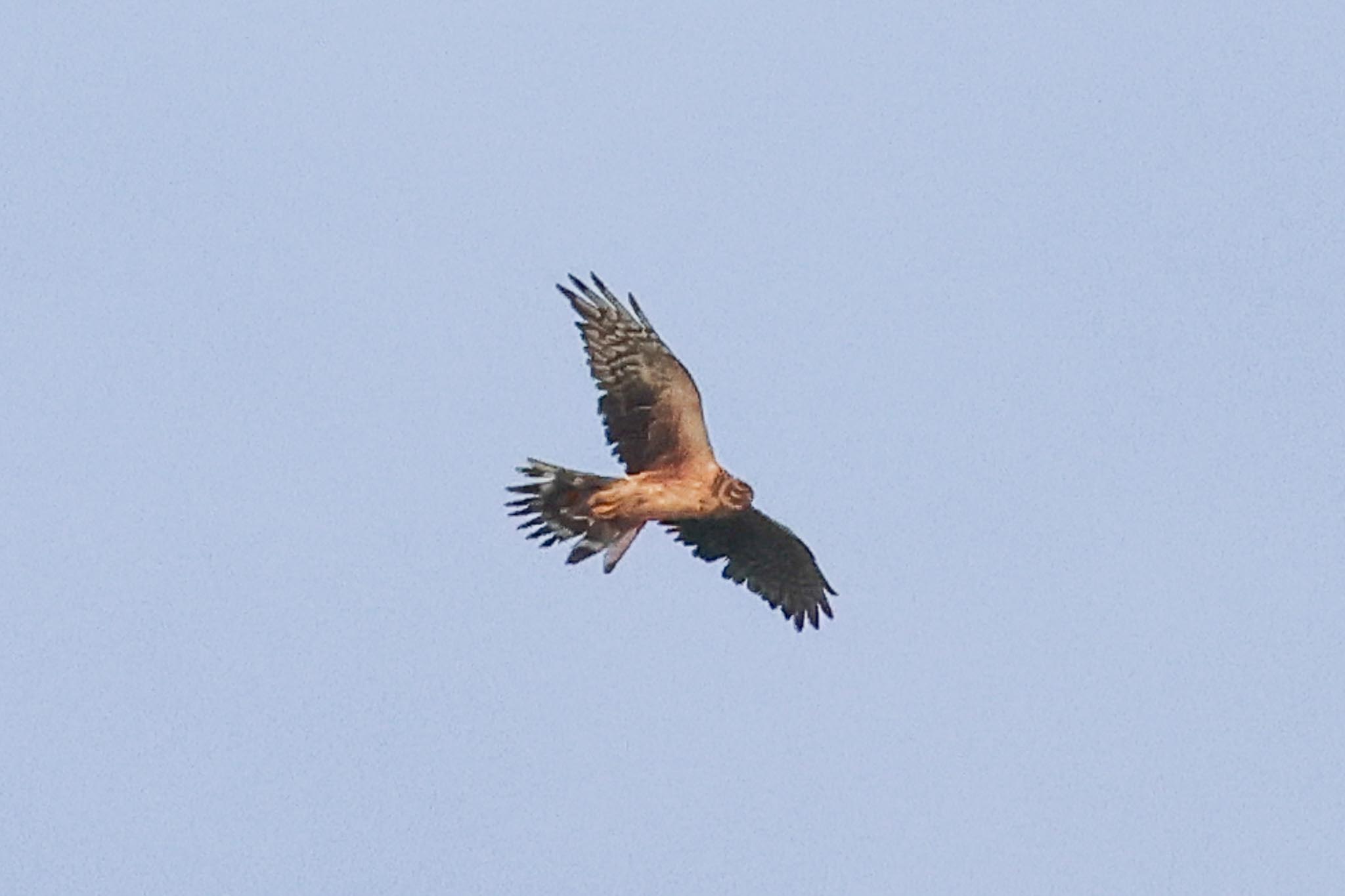
We were doing well for raptors already, and this is a good spot for Merlin at this time of year. We had just said as much when someone to our right said he could see one hunting pipits high in the sky. It was clearly very distant, and he had no reference point, so we couldn’t work out where he was looking. He lost sight of it and we continued to scan the saltmarsh, and quickly fount it or another Merlin on a post out on the edge of the beach. It was distant too, but through the scopes you could see what it was.
It was a lovely early evening now, and the Pink-footed Geese were starting to fly in from the fields inland, dropping down onto the sand bar out on the beach to roost. Half of group decided to start walking back – the path was muddy and it had been slow going on the way out. The rest waited a little longer, taking in the scene. As we eventually headed back, we stopped to talk to one of the locals who was stood beside the path. We looked back and noticed another ringtail Hen Harrier coming straight towards us, hunting the bushes either side of the path. It saw us and flew round behind the bushes on the inland side of the path but when it came out the other side it flew straight past us. Stunning close views!
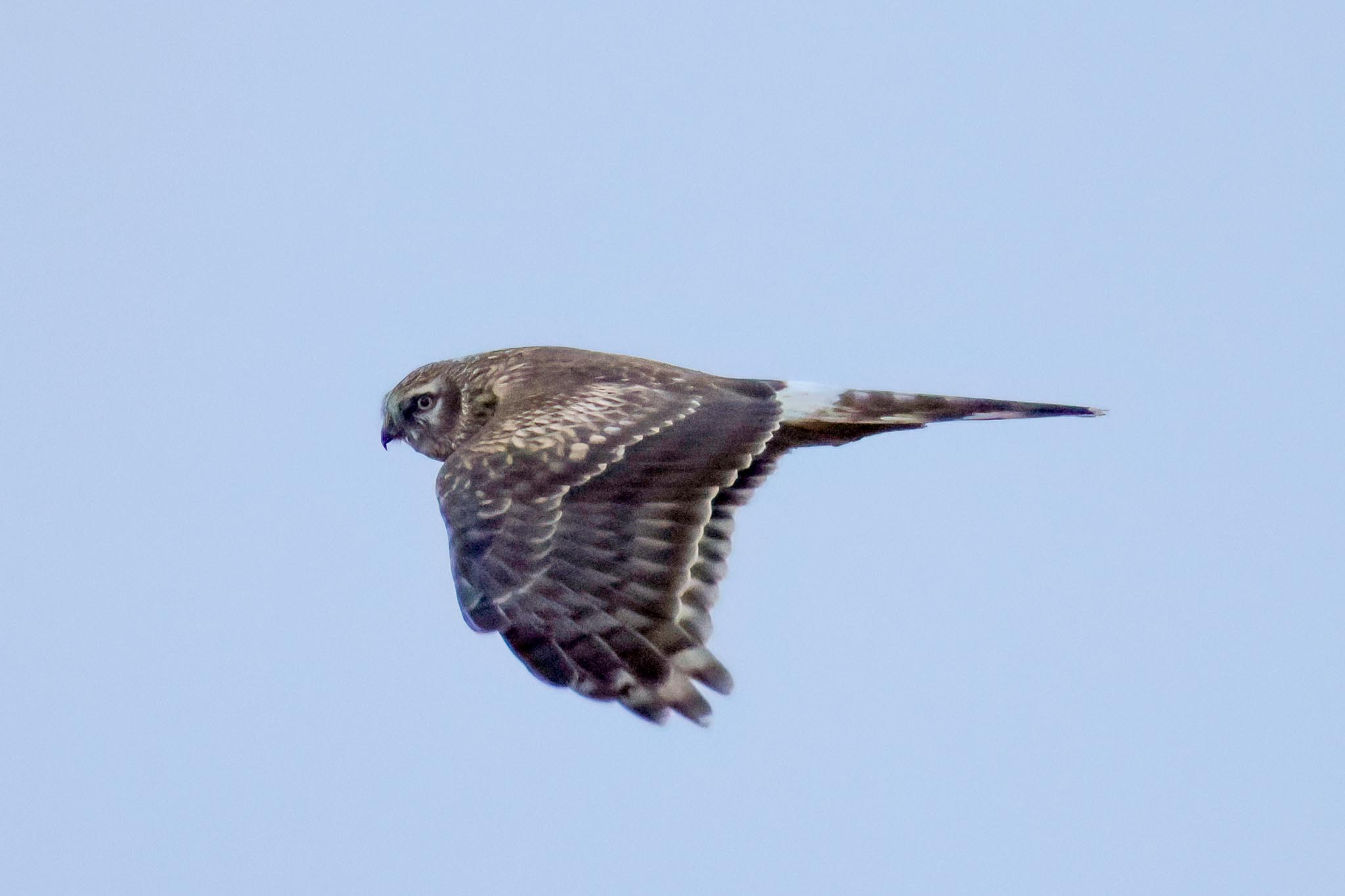
The light was starting to go now. It had been a great afternoon, and the day had been a long way from the washout which it was predicted to be.
















